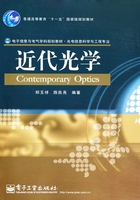
1.4 电磁波的偏振[11],[13~16]
1.4.1 电磁波的横波性
在上节得到了电场强度矢量E和磁场强度矢量H满足的波动方程,该方程的解表示传播速度为 的一种波动,其最简单的形式为简谐波。对于简谐波,E和H的表达式为
的一种波动,其最简单的形式为简谐波。对于简谐波,E和H的表达式为


将上式代入麦克斯韦方程组得




由式(1.4-2)可以看出,矢量E和矢量B都与电磁波的传播方向k垂直,这表明电磁波是横波,且E,B,k之间构成右手螺旋关系,在数值上有


在各向同性介质中,B与H的方向相同,且E与D的方向也相同。令 E 与 H 的比值为Zc,表示为

Zc是描述介质空间特性的参量,称为介质的特性阻抗。真空的特性阻抗为

因此介质的特性阻抗可写为

对于常用的光学介质,其相对磁导率近似为1,即μr≈1,于是有

1.4.2 洛伦兹力公式
考虑一个处在电磁场中、带电量为q、运动速度为v的粒子,它所受到的洛伦兹力为

在真空中,E与B的大小满足

因此,运动带电粒子在电磁场中所受到的电场力和磁场力之比为

上式中θ为v与B之间的夹角。由于v≪c,运动带电粒子在电磁场中所受到的电场力比磁场力大得多。因此,在非相对论情况下,当考虑物质与光的相互作用时,仅考虑光的电场分量。但在有些情况下,如在处理有些非线性问题时,光的磁场分量的作用是不能忽略的。
1.4.3 光的偏振
由于电磁波是横波,所以具有偏振特性。所谓偏振是指振动方向相对于传播方向的不对称性,通常包括线偏振,圆偏振和椭圆偏振等几种形式。
当光与物质相互作用时,主要是光波中的电矢量起作用,所以常用电矢量作为光波的振动矢量,即光矢量。光矢量在垂直于传播方向的平面内作二维振动,存在多种不同的振动状态,称为光波的偏振态。一般按偏振态将光分成五种类型:自然光、线偏振光、部分偏振光、圆偏振光和椭圆偏振光。
1.自然光
普通光源,例如太阳、白炽灯等,发出的光,其光矢量沿各个方向均匀分布,且沿各方向振动的振幅相等,各振动之间没有固定的相位关系。具有这种偏振态的光称为自然光,如图1.4-1所示。

图1.4-1 自然光光矢量的振动分布
2.线偏振光
在垂直于传播方向的平面内,光矢量沿固定方向振动,具有这种偏振态的光称为线偏振光。因为线偏振光在传播过程中,各处的光矢量均在一个平面内,故线偏振光又称为平面偏振光,如图1.4-2所示。通常把光矢量振动方向与传播方向所构成的平面称为振动面。由于光矢量就是光的电场振动矢量,因此电场矢量在振动面内振动,而把磁感应强度矢量振动方向与传播方向所构成的平面称为偏振面。显然振动面与偏振面相互垂直。

图1.4-2 线偏振光光矢量的振动分布
3.部分偏振光
如果偏振光的光矢量沿各个方向都有振动,且沿各方向振动的振幅不等,具有这种偏振态的光称为部分偏振光,如图1.4-3所示。部分偏振光是介于自然光和线偏振光之间的一种偏振光,一般可以把部分偏振光看作是自然光和线偏振光两者的混合。

图1.4-3 部分偏振光光矢量的振动分布
部分偏振光在某一个方向上振动占优,若用偏振片来检验,当偏振片的透振方向沿该方向时,透射光有极大值IM;当偏振片的透振方向垂直于该方向时,透射光有极小值Im。为了描述部分偏振光的偏振程度,引入偏振度P,其定义为

当IM=Im,即P=0时,对应的光为自然光,自然光是偏振度为零的光,也叫非偏振光。当Im=0,即P=1时,对应的光为线偏振光,线偏振光是偏振度为1的光,也叫完全偏振光。
4.圆偏振光
如果一束光在传播过程中,其光矢量的大小不变,但方向以角速度ω在垂直于传播方向的平面内旋转变化,光矢量的端点描绘出一个圆形,具有这种偏振态的光称为圆偏振光,如图1.4-4所示。如果在光传播的前方迎面看,则当光矢量沿顺时针旋转时,对应的光称为右旋圆偏振光;相反,当光矢量沿逆时针旋时,对应的光称为左旋圆偏振光。

图1.4-4 圆偏振光光矢量的振动分布
5.椭圆偏振光
如果光在传播过程中,光矢量以角速度ω在垂直于传播方向的平面内旋转,且光矢量的大小也发生变化,光矢量的端点描绘出一个椭圆,具有这种偏振态的光称为椭圆偏振光,如图1.4-5所示。

图1.4-5 椭圆偏振光光矢量的振动分布
与圆偏振光一样,椭圆偏振光也分为左旋椭圆偏振光和右旋椭圆偏振光,并且左、右旋的定义与圆偏振光左、右旋的定义一样,即在光传播的前方迎面来看,光矢量沿顺时针旋转的椭圆偏振光称为右旋椭圆偏振光;光矢量沿逆时针旋转的椭圆偏振光称为左旋椭圆偏振光。一般地,不同的椭圆偏振光的长轴与x轴的夹角,以及长短轴之比是不同的。特别地,当短轴为零时,椭圆偏振光变成线偏振光;当短轴与长轴相等时,椭圆偏振光变成圆偏振光。这表明,椭圆偏振光是最普遍的偏振光,而线偏振光和圆偏振光是其特例。
1.4.4 偏振态的表征
1.椭圆偏振光的数学表示
前面提到,线偏振光和圆偏振光是椭圆偏振光的特例,而椭圆偏振光可表示为两个互相垂直的线偏振光的合成,即


式中,τ=ωt-k·r。注意到在τ=ωt-k·r中,ωt前的系数为正,这样选的结果是正相位表示超前(与大多数讨论偏振的光学书籍中的选取方式一致)。因此,在式(1.4-13b)中,δ表示Ey超前于Ex的相位。实际上,由于


令


对于特定的空间点,Ex的相位φx在达到与Ey的相位φy相同时,必须要经过Δt=δ/ω的时间。也就是说,Ey的相位比Ex的相位超前δ。
椭圆长短轴及旋转方向与x、y方向的振动分量的振幅Ex0、Ey0 及相位差δ有关,如图1.4-6所示。一般地,合成的椭圆形状如图1.4-7所示,设椭圆长轴与x轴的夹角为θ,不妨建立新的坐标系ox'y',使x'轴沿椭圆长轴,y'轴沿椭圆短轴,在新坐标系中 与原坐标中Ex、Ey之间满足
与原坐标中Ex、Ey之间满足


图1.4-6 各种相位差的椭圆偏振光光矢量振动示意图

图1.4-7 椭圆偏振光各参量之间的关系
式中,矩阵A为

令椭圆的长轴、短轴的长度分别为2a、2b,则在ox'y'坐标系中,椭圆方程可表示为


上式中,正、负号分别对应左旋、右旋椭圆偏振光。由式(1.4-13)、式(1.4-17)至式(1.4-19)得




式(1.4-20a)与式(1.4-20b)平方相加,及式(1.4-20c)与
式(1.4-20d)平方相加得到


式(1.4-21a)与式(1.4-21b)相加,得到

式(1.4-20a)与式(1.4-20c)相乘,及式(1.4-20b)与式(1.4-20d)相乘,然后再相加得到

式(1.4-20a)除式(1.4-20c),及式(1.4-20b)除式(1.4-20d),得到

上式第二个等号两侧交叉相乘得到

引入辅助角α,令

这样,可以将式(1.4-25)改写为

由式(1.4-22)和式(1.4-23)得

引入另一个辅助角η,令

其中正、负号分别对应右旋、左旋椭圆偏振光。进一步将式(1.4-28)改写为

通过以上讨论可知,如果给定θ、η的实际值(这些值可以由实验测定),则偏振光的两个正交分量的振幅Ex0、Ey0及相位差δ可以通过以下公式求出,即




2.琼斯矢量和琼斯矩阵
1941年,琼斯(R. C. Jones)提出用矢量和矩阵分别表示偏振态和偏振器件的特性。这种方法对分析光在各种偏振器件中的传播问题非常方便。
1)琼斯矢量
假设一个任意偏振态的光沿z轴传播,其光矢量在xy平面内振动。由前面的讨论可知,在xy平面内振动的光矢量可以视为x、y方向光矢量振动的合成,用矢量形式可以表示为

由于偏振态取决于两振动方向相对振幅与相对相位,而与公共相位因子无关,所以可以略去式(1.4-35)中公共相位因子,而不影响偏振态的表征,于是得到

上面得到的矢量就是琼斯矢量。由于光的强度并不影响偏振状态,因此可以引入归一化的琼斯矢量,将其定义为

显然,归一化的琼斯矢量表示的偏振光具有单位强度的光强。
【例1.4-1】 试用归一化的琼斯矢量表示下列偏振光。
① 光矢量与x轴夹角为θ的线偏振光;
② 左旋圆偏振光。
解:
① 与x轴夹角为θ的线偏振光,其光矢量的两个分量分别为

归一化后得到

② 左旋圆偏振光,其光矢量的两个分量分别为

即其Ey比Ex落后π/2,略去公共因子,并归一化得到

2)琼斯矩阵
一般地,偏振光经过偏振元件,其偏振态将发生变化。假设偏振光E1,经过一个偏振器件P后,变成偏振光E2。E1、E2对应的琼斯矢量分别为

由矩阵分析的知识可知,E1与E2可以由一个矩阵联系,即

引入琼斯矩阵J,其定义为

显然,每一种偏振器件对偏振光的变换特性都可以用一个琼斯矩阵来描写。
如果偏振光依次经过N个偏振器件,它们的琼斯矩阵分别为J1,J2,…,JN,容易得到出射光E的偏振态为

由于琼斯矢量涉及光矢量的瞬时值,需要知道两个正交电场分量之间的相对相位关系,因此琼斯矢量仅限于描述完全偏振光。
3.正交偏振态
1)偏振态的正交性
假设有两个偏振光,其琼斯矢量分别为

如果将其中一个琼斯矢量取复共轭,再与另一个琼斯矢量作内积(即点积)后,结果为零,即

则称两偏振光正交。不难验证,沿x轴振动的线偏振光与沿y轴振动的线偏振光正交;左旋圆偏振光与右旋圆偏振光正交。由矢量分析的知识可知,在同一个平面内,任意矢量可以由两个正交矢量叠加而成。同样道理,任意偏振光也可以由两个相互正交的偏振光叠加得到。
2)笛卡儿基矢量和圆基矢量
设有两个相互垂直、具有单位强度的线偏振光,其光矢量分别沿x、y轴,以零初相位和单位振幅作简谐振动,对应的琼斯矢量为

对于任意偏振光,其琼斯矢量为

显然,E可以用 表示为
表示为

因此任意琼斯矢量E可以用 展开
展开 所起的作用与欧几里得空间中的基矢量相似,称为琼斯基矢量。这组琼斯基矢量是由相互正交的零初相位、单位振幅的线偏振光组成,称为笛卡儿琼斯基矢量。
所起的作用与欧几里得空间中的基矢量相似,称为琼斯基矢量。这组琼斯基矢量是由相互正交的零初相位、单位振幅的线偏振光组成,称为笛卡儿琼斯基矢量。
设有两个相互正交、具有单位强度且初相位为零的圆偏振光,其琼斯矢量分别为

上面左式表示左旋圆偏振光,它可看作是光矢量分别沿x轴振动和沿y轴振动的两个分量叠加而成,这里两个振动分量的振幅均为 ,并且y轴振动分量落后于x轴分量π/2。上面右式表示右旋圆偏振光,它与左旋圆偏振光不同的是,y轴振动分量超前于x轴分量π/2。将笛卡儿琼斯基矢量
,并且y轴振动分量落后于x轴分量π/2。上面右式表示右旋圆偏振光,它与左旋圆偏振光不同的是,y轴振动分量超前于x轴分量π/2。将笛卡儿琼斯基矢量 用
用 表示为
表示为


可见 也可起到基矢量的作用,称为圆基矢量。
也可起到基矢量的作用,称为圆基矢量。
3)笛卡儿琼斯矢量和圆琼斯矢量
对于任意偏振光E可以用 表示为
表示为

式中

可将Ex、Ey与EL、ER关系写成

或者

式中



这里,Ex,y是用x、y线偏振光基矢量展开的琼斯矢量,称为笛卡儿琼斯矢量;而EL,R是用左旋圆偏振光、右旋圆偏振光基矢量展开的琼斯矢量,称为圆琼斯矢量。
下面通过一个例子来说明用笛卡儿琼斯矢量与用圆琼斯矢量表示同一个偏振态的异同。不失一般性,先看一个单位振幅、零初相位的椭圆偏振光,假设椭圆长轴与短轴分别与x'、y'轴重合。在o'x'y'系中,其琼斯矢量为

在oxy系中,长轴与x轴夹角为θ,θ代表椭圆的空间取向,称为方位角;而η则代表椭圆的“胖瘦”程度,称为椭圆率角,简称椭率角。再考虑到偏振光的振幅A、初相位δ0后,则在oxy系中完整偏振态的琼斯矢量表示

上式描述一个振幅为A、初相位为δ0、方位角为θ、椭率角为η的偏振光。式(1.4-57)为该偏振光的笛卡儿琼斯矢量。根据笛卡儿琼斯矢量与圆琼斯矢量的变换关系

容易得到

上式即振幅为A、初相位为δ0、方位角为θ、椭率角为η的偏振光的圆琼斯矢量。
4.斯托克斯矢量和穆勒矩阵
1)斯托克斯参量
1852年,斯托克斯(G.G.Stokes)提出用四个参量来描写光波的强度和偏振态,这四个参量称为斯托克斯参量,它们构成一个四维矢量,即斯托克斯矢量。构成斯托克斯矢量的四个参数均是被考虑光分别通过四块特殊滤波片F1、F2、F3、F4后的光强平均值,这四块滤波片F1、F2、F3、F4的功能为:
① 每块滤波片对自然光的透过率均为50%;
② 每块滤波片的通过面垂直于入射光;
③F1是各向同性的,对任何入射光的作用相同;
④F2的透光轴(透振方向)沿x轴,对沿y轴振动的光完全吸收;
⑤F3的透光轴与x轴夹角为45°;
⑥F4对左旋圆偏振光完全吸收。
设光通过四块滤波片的光强分别为I1、I2、I3、I4,引入四个参量s0、s1、s2、s3,定义为




这四个参量构成的矢量S称为斯托克斯矢量,即

由于构成斯托克斯矢量的四个参量对完全偏振光、部分偏振光和自然光都可以确定,因此斯托克斯矢量可以描述完全偏振光、部分偏振光以及自然光,而琼斯矢量只能表示完全偏振光,这是斯托克斯矢量表示的优点。但斯托克斯矢量是四维矢量,而琼斯矢量是二维矢量,因此在运算方面,用琼斯矢量表示方法更便利一些。
对完全偏振光,若光矢量的两分量分别为


式中,τ=ωt-k·r。可以证明,该完全偏振光对应的斯托克斯矢量的各参量为




显然,对完全偏振光,四个参量之间存在如下关系

2)穆勒矩阵
类似于琼斯矢量的讨论,设偏振光E1经过一个偏振器件P后变成偏振光E2。E1、E2对应的斯托克斯矢量分别为

S1与S2可以由一个矩阵联系,即

引入一个4×4矩阵M,令

M称为穆勒矩阵。同样,每一种偏振器件对偏振光的变换特性也可以用一个穆勒矩阵来描写。如果偏振光依次经过N个偏振器件,它们的穆勒矩阵分别为M1,M2,…,MN,容易得到出射光E的偏振态为

5.琼斯矢量与斯托克斯矢量的关系
对一个完全偏振光,既可以用琼斯矢量表示,也可以用斯托克斯矢量表示,因此两者之间一定存在变换关系。
设一个完全偏振光为


它的琼斯矢量可写为

它的斯托克斯矢量形式为




为表达方便起见,引入四个矩阵

上面四个矩阵称为夹心矩阵,类似于量子力学中描述电子自旋的泡利矩阵。另外,琼斯矢量的共轭矢量为

不难验证,四个斯托克斯参量可以表示为




表1.4-1中列出了各种偏振光状态的矢量表示。
表1.4-1 偏振光状态的矢量表示

6.偏振光的复平面表示法
1)笛卡儿复平面表示法
一个振幅为A、初相位为δ0、方位角为θ、椭率角为η的椭圆偏振光的笛卡儿琼斯矢量为

应该记住,圆偏振光和线偏振光是椭圆偏振光的特例。在大多数情况下,偏振光的振幅和初相位不是人们考虑的重点,实际上在很多光学的应用中,光源的功率大小以及时间、空间原点的选择不会给实验结果带来本质的影响。因此,在上式中,公共因子Aexp(iδ0)可以忽略。在笛卡儿琼斯矢量的表示中,一个任意椭圆偏振光被视为分别沿x轴和y轴振动的线偏振光分量的矢量合成。这两个振动分量之间的振幅比和相位差是区分不同偏振态的重要物理参量。在几何上,一个椭圆偏振光正如其名称那样,可以用一个椭圆(即偏振椭圆)表示,而偏振椭圆的方位角和椭率角是区分不同偏振椭圆的重要几何参量。引入偏振变量Γ,令

显然,偏振变量Γ是由两个振动分量之间的振幅比和相位差构成的复变量,不同的椭圆偏振态对应于不同的偏振变量Γ。另外,偏振变量Γ可以由偏振椭圆的方位角和椭率角表示为

上式表明每一个方位角为θ和椭率角为η的椭圆偏振态可以由一个复数Γ表示。每一个复数则对应于复平面上的一个点,因此可以用复平面来表示光的偏振态。因为复平面每一点对应的表示偏振态的复数是由笛卡儿琼斯矢量的分量定义得到的,所以这种复平面表示称为笛卡儿复平面表示。注意到,方位角θ和椭率角η的范围为-π/2≤θ<π/2,-π/4≤η≤π/4。
式(1.4-77)给定复平面上的一个点,该点对应的复数描写的偏振态由式(1.4-76)表示。通过仔细分析复平面上的点与光的各种偏振态之间的一一对应关系,可以总结出笛卡儿复平面表示的特点:
① 复平面的原点(Γ=0)表示沿x轴振动的线偏振光;复平面的无穷远点(Γ=∞)表示沿y轴振动的线偏振光。
② 复平面的实轴上从-∞~∞之间的点表示方位角从-π/2~π/2的线偏振光。
③ 虚轴上的两点,R(0,i)与L(0,-i)分别表示右旋圆偏振光和左旋圆偏振光。
④ 除实轴上各点、虚轴上的R(0,i)与L(0,-i)两点及无穷远点之外,复平面上其他各点均表示椭圆偏振光。其中,上半平面的点表示右旋椭圆偏振光,下半平面上各点表示左旋椭圆偏振光。
⑤ 在复平面上,通过R(0,i)、L(0,-i)两点所在的圆过原点作弦,该弦两端的点表示的偏振态相互正交。
⑥ 在复平面上,通过R(0,i)、L(0,-i)两点的圆被虚轴分为左右两支,右半平面的分支(弧)表示的偏振态具有相同的方位角θ,并且0<θ<π/2;左半平面的分支(弧)表示的偏振态也具有相同的方位角(θ-π/2),并且-π/2<θ-(π/2)<0。
⑦ 在复平面上,圆心位于(0,icosec2η)、半径为|ctan2η|的圆上各点表示的偏振态具有相同的椭率角η。
以上结果的证明从略,留给感兴趣的读者练习。
2)圆复平面表示法
一个振幅为A、初相位为δ0、方位角为θ、椭率角为η的椭圆偏振光的圆琼斯矢量为

在这种情况下,偏振变量Γ为

由圆琼斯矢量表达式,得到偏振变量Γ与偏振椭圆的方位角θ和椭率角η之间的关系为

偏振变量Γ是一个复数,对应复平面上的一个点,由式(1.4-77)可以得到该点表示的偏振态的方位角θ和椭率角η分别为


偏振态与该复平面上的点存在一一对应关系,用该复平面表示偏振光的方法称为偏振光的圆复平面表示。对式(1.4-80)、式(1.4-81)及式(1.4-82)进行分析,可以得到圆复平面表示的特点:
① 复平面的原点(η=-π/4,Γ=0)和无穷远点(η=π/4,Γ=∞)表示左旋圆偏振光和右旋圆偏振光。
② 复平面单位圆上的每个点(η=0,-π/2≤θ<π/2,Γ=exp(-i2θ))对应于不同方位角的线偏振光。
③ 除原点、单位圆和无穷远点外,复平面上其他各点均表示椭圆偏振光。其中,在单位圆外(0<η≤π/4,1<|Γ|<∞)各点表示右旋椭圆偏振光;在单位圆内(-π/4≤η<0,0≤|Γ|<1)各点表示左旋椭圆偏振光。
④ 等方位角线(θ=常数)为从原点发出,直到无穷远的径向辐射线。正实轴为θ=0的等方位角线;负实轴为θ=-π/2的等方位角线。一条通过原点的直线被原点截成两支,一支表示所有方位角为θ的偏振态;另一支表示所有方位角为θ-(π/2)的偏振态,其中一支中的偏振态与另一支对应偏振态正交。
⑤ 在复平面上,圆心位于原点的圆上各点表示的偏振态具有相同的椭率角η。
7.偏振态的邦加球表示法
1892年,邦加(J. H. Poincaré)提出用球体表示任意偏振态的图示法,这种可表示任意偏振态的球称为邦加球。
1)邦加球表示法的基础
前面提及,对于完全偏振光,四个斯托克斯参量为




δ=δy-δx为Ey与Ex之间的相位差,因为上式描述的是完全偏振光,所以

根据式(1.4-83d)、式(1.4-32)及式(1.4-33)可以得到

由式(1.4-31)及式(1.4-33)可得

或

将上式及式(1.4-85)代入式(1.4-84)可得

将上式代入式(1.4-87)得到

于是获得斯托克斯参量与偏振椭球的方位角和椭率角之间的关系为



2)偏振光的邦加球表示法
正如前文所述,如果不考虑光强,只需两个角度,即方位角θ和椭率角η,就可决定任意椭圆偏振光的偏振态,注意到
方位角θ:-π2 ≤θ< π2,椭率角η:-π4 ≤η≤ π4
联想到球面上的一点可以由该点对应的经度和纬度这两个方位角表示,如果将球面上的经度和纬度分别与椭圆偏振光的方位角和椭率角联系起来,那么球面上的一个点就可以代表一个偏振态。由式(1.4-90)可以想到,以s0 为半径作球面,令球面各点对应的经度和纬度分别为2θ和2η,则球面上每一个点的直角坐标恰为斯托克斯参量s1、s2、s3,球面全部点与所有各种可能的完全偏振态一一对应,这种球就是邦加球,如图1.4-8所示。关于邦加球,有以下结论:

图1.4-8 偏振光的邦加球表示
① 赤道上(η=0),任意一点代表不同振动方向的线偏振光,其中θ=0,即x轴正半轴上的点表示水平偏振光;θ=π/2,即x轴负半轴上的点表示垂直偏振光。
② 球的北极(η=π/4)表示右旋圆偏振光;南极(η=-π/4)表示左旋圆偏振光。
③ 北半球上的每一点表示右旋椭圆偏振光;南半球上的每一点表示左旋椭圆偏振光;椭圆相应的方位角和椭率角分别为该点经度和纬度值的一半;因此,θ为常数的所有点表示所有方位角相同而椭率角不同的椭圆偏振光;η为常数的所有点表示所有椭率角相同而方位角不同的椭圆偏振光。
④ 相对球心对称的两点,即球直径的两端,对应的偏振光是正交偏振光。
3)自然光、部分偏振光与邦加球表示法
除能表示完全偏振光外,斯托克斯矢量还能表示部分偏振光及自然光。对部分偏振光,可以证明,有下面不等式成立,即

部分偏振光S可理解为自然光Sun与完全偏振光Spo的叠加,即

或者

这里

对于完全偏振光Spo,它的斯托克斯参量与偏振椭圆的方位角θ、椭率角η之间满足

完全偏振光可以由邦加球面上的一点表示,这里邦加球的半径为 ,经度和纬度分别为2θ、2η。
,经度和纬度分别为2θ、2η。
定义部分偏振光的一个重要参量偏振度P为

于是,部分偏振光的斯托克斯矢量可表示为

若将总光强归一化,即令s0=1,此时邦加球为单位球。偏振态由P、θ、η决定,不难发现:
① 在邦加球球心处,P=0,表示自然光;
② 在邦加球球面上,P=1,表示完全偏振光;
③ 在邦加球内任意一点,0<P<1,表示部分偏振光;
④ 在邦加球外的点,P>1,没有物理意义。